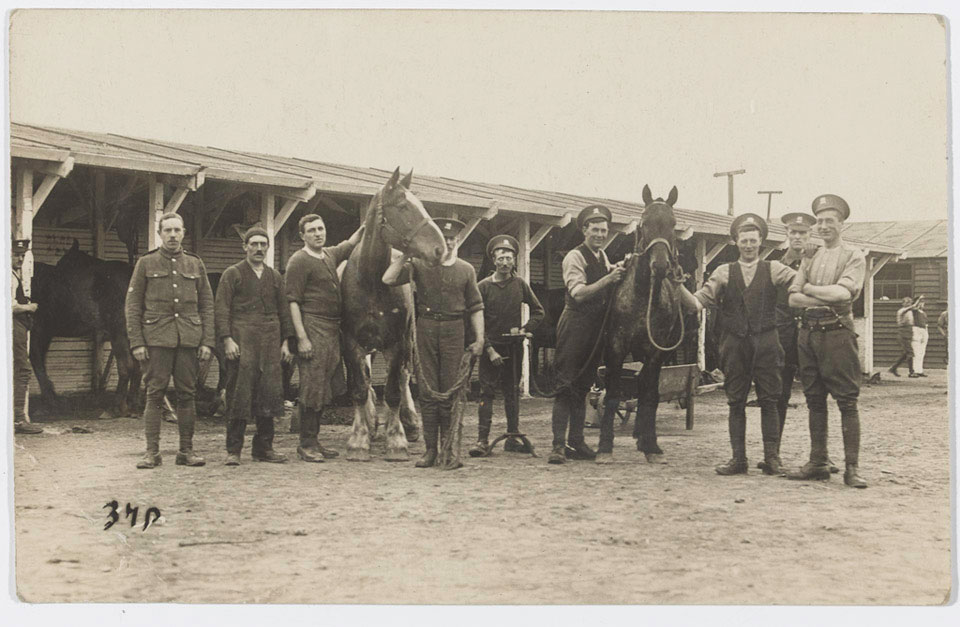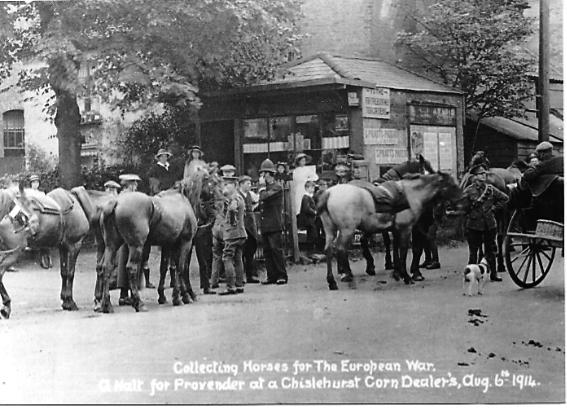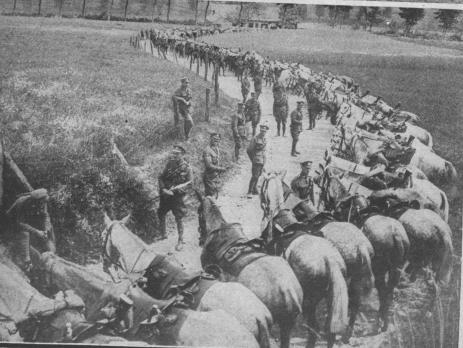Horses in the First World War
Written by Pam Preedy.
We sometimes forget that horses were essential to the Army during World War One. Much attention has been focused on the dreadful conditions and sufferings of the men in the trenches, yet the suffering was shared by the horses as seen in the book, play and film War Horse by Michael Morpurgo. All the armies used horses and mules.
At the outbreak of war, there were 25,000 horses at the disposal of the British Army. Under the Horse Mobilisation Scheme of August 1914, the number of horses purchased increased to 115,000. They had work to do including pulling the artillery and equipment carts and riding into battle with the men.
Horses were disposable
For every two men who were lost, one horse was killed.
In September 1916, during the battle of Verdun, 97 horses were killed by a single shot from a French naval gun.

(National Army Museum, London)
In the first few weeks of the war in Bromley, members of the Remount Service of the British Army commandeered and purchased horses from the local areas.
Sometimes this was of great inconvenience to the owners as the horses were in use at the time, and would have a deleterious impact on their businesses, particularly those serving the people in the town.
Horses were commandeered
“A horse belonging to the Co-operative Society was taken from the shafts and commandeered.
Mr Rogers, cab proprietor, Bromley South, had six horses taken on Wednesday morning. Mr Rogers’ cabs were busily engaged on Wednesday conveying to their homes persons returning, in many cases hurriedly, from their holidays, and persons going to military centres. Owing to the demand for horses by the Government, some of the tradesmen in town find it difficult to make their deliveries, and they are appealing to their customers to assist them as much as possible by fetching goods.
Whereas, it seems to have been less of a problem for the rural districts in Bromley, it is understood that farmers throughout the district are quite satisfied with the way that they have been treated with regard to the taking of horse for military use”
Bromley & District Times, 14th August 1914 (page 4)


Mechanised means of transport were only just coming onto our streets and onto the battlefields – initially in the form of motor bikes and buses for the troops, and then the introduction of tanks into the fight in September 1916.
Conditions were severe for horses and mules at teh front. Many suffered wounds in battle, mange, were injured by poison gas, endured exhaustion and some suffered mental problems Mobile veterinary sections were established to take the sick and wounded to veterinary hospitals where they could be treated. A typical veterinary hospital could take 2,000 patients.
It was up to the Remount Service to care for the horses and mules once they had been treated by the vets.
The success rate was high: 2.5 million animals were hospitalised in France and two million were returned for duty at the front. In Egypt there were also separate camel hospitals under the command of Army Veterinary Corps officers with specialist knowledge of camels.

In Bromley Mr L.Y. Squire came to talk about the work of the Veterinary Department in France:
“The society (RSPCA) had supplied thousands of wither pads and sheep skins for the horses. they had also undertaken to give lectures to the recruits in training camps, and had distributed 48,000 leaflets on the question of first aid to horses. The society had supplied and were maintaining six ambulances, with ointments and dressings for use in the field”
Arthur J. Coke secretary of the Blue Cross Fund, (nothing to do with the RSPCA) asking for help, said
“In France a hospital had been built to accommodate a thousand horses. One thing that they were very much in need of – rugs.”
Horses and mules were essential to the Army during World War One. They shared the trials and tribulations with their humans. They gave their lives, but could have no understanding of the reason why they were called upon to work in such appalling conditions.
Further your research
For more information visit the Bromley Historic Collections on the 2nd floor of Bromley Central Library to learn more about Bromley Borough’s history.
Originally published in Life in Bromley magazine (Issue 8, October 2022)
